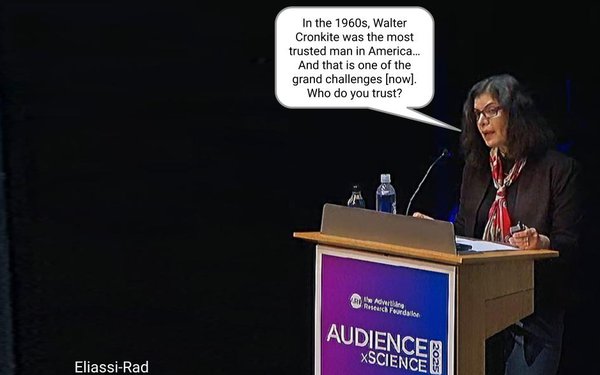
Day Two of the
Advertising Research Foundation’s (ARF) Audience x Science Conference in New York City provided insights and warnings on AI, outlined the status of Association of National Advertisers’
Aquila venture, and raised questions on the evolution and role of media planning in today’s technopolistic marketplace.
Multiple challenges, limits and dangers
associated with human-AI co-evolution were addressed by Northeastern University Professor Tina Eliassi-Rad.
She underlined that the paradox of Big Data is there is not
enough information or measurement on any one person to predict a detailed profile of that person.
Consequently, this requires the use of proxy data that, in and of itself, is
inadequate or inaccurate. The result for AI analytics and outputs, as she suggested, is that “it is not clear what is fake and what is real.” Generative AI has “lots of
risks.”
advertisement
advertisement
With problems identifying “The Truth” – notably in the ad and media measurement world – the question she raised is, “Who do
you trust?”
This echoed Rashid Tobaccowala’s stress on the value of trust from the first day of the ARF event.
As, who I would call, an
“over-seer” in understanding and measuring the feedback loop between us and AI agents, I believe we can take comfort that Tina and her associates will help us balance exploitation versus
exploration in this technological advance for society, which is so critical to enhancing the science of our ad and media industries.
“Education in its broadest
sense will save humanity,” she remarked. Hopefully, she is right.
The industry’s on-going issues with the opaqueness of walled garden data, notably by
the social media “death stars,” was the opening line from Aquila President-COO Tina Daniels.
This ANA LLC initiative, at its fundamental level, hopes to
provide the industry with unduplicated cross-platform reach and frequency at relatively low cost based on “normalized total impressions” (not defined), especially for use in marketing mix
models and understanding campaign outcomes.
This undertaking parallels a similar initiative – ISBA’s “Project Origin” in the U.K. – which
has been encountering a myriad of complex concerns still to be resolved. Thankfully, neither project is aiming to be, or has ambitions to be, a “media currency.”
However, both are based on the World Federation of Advertisers’ (WFA) “Project HALO” open-source cross-media reach and frequency model.
Importantly, both
U.S. and international discussions so far have shied away from the use and value of a meaningful and relevant definition and derivation of an impression to be used in those models.
On top of which, the primary funding and model development is being driven by Google, as well as other major social media platforms. Surely that’s problematic?
Which is why
TV broadcasters in the U.K., to say the very least, are leery of involvement or use of their audience data in these cross-media projects and have significant concerns with Google’s influence and
reluctance to involve any more than YouTube data.
As Daniels stated, Aquila needs many more partners.
Achieving real, meaningful and relevant
unduplicated cross-media reach and frequency based on persons-based measures of actual content exposure is a Holy Grail that is desperately needed and the WFA, ISBA and the ANA are to be applauded for
their initiatives.
The objective has become ever more complex, including issues with the use of Big Data, VIDs (virtual IDs) and calibration panels in measuring and
understanding our exploding digital world. So, there is a very long way to go to ensure that these terrific initiatives are truly comprehensive and unbiased.
The
industry’s eminent economist, Madison and Wall’s Brian Weiser concluded the conference by outlining the status and questions as to whether the future of planning is the platform? The
power and influence of the “death stars” that can do it all – from planning to buying, as well as outcomes measurement – in many different formats and via many different
devices.
From a detailed analysis by his company, the gap between plans and buys have become ever wider which results in the “platform” becoming the ad spending
“line item” rather than media like TV, newspapers, radio, out-of-home, etc. The horizon for this evolution? Likely five years.
His analysis and
assessment importantly underpin the current questions and concerns regarding principal-based buying by media agencies, which at one time was considered unethical, possibly even illegal. If this
continues to evolve it could fuel the rise of boutique creative agencies, as creative is still king.
In addition, he asked, how would other media owners evolve and
compete? And would the “Platforms” measure and grade their own homework? More urgent topics for ARF to address?